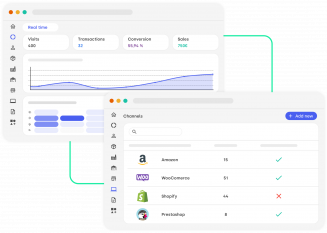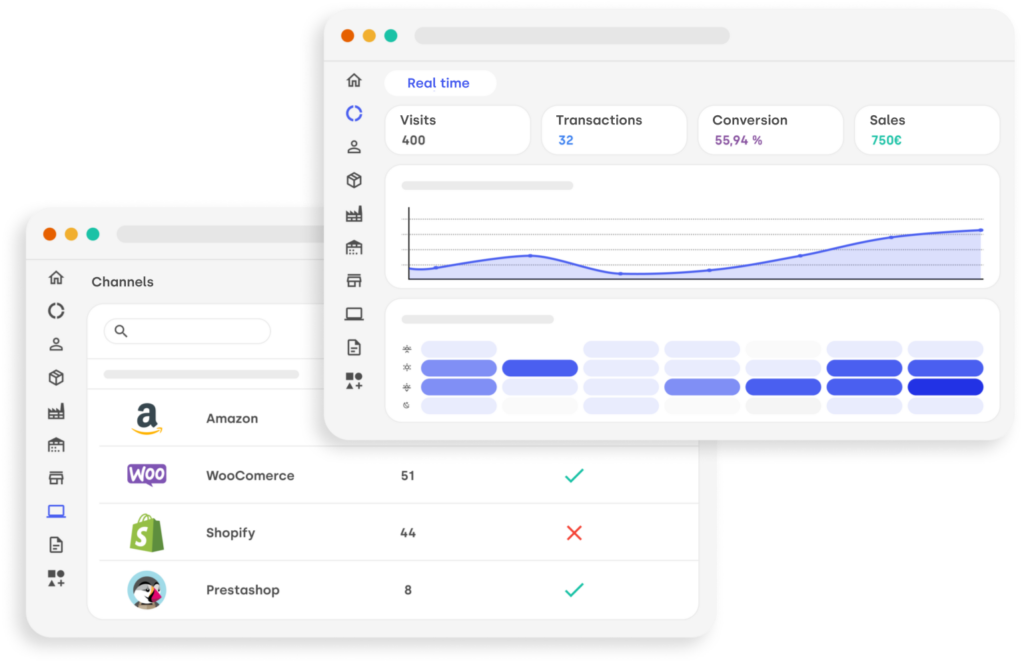Warehouse Management Systems (WMS) have evolved from mere inventory tracking systems to sophisticated software solutions that manage everything from order picking to distribution. In this guide, we delve deep into the various types of WMS, smart warehousing technologies, and the significance of these systems in today’s logistics and supply chain management.
Types of Warehouse Management Systems – Advantages & Drawbacks
Standalone WMS
Standalone Warehouse Management Systems are usually on-premise solutions. They offer high levels of customization but may require a considerable upfront investment. As these systems age, integrating them with newer technologies can be challenging.
Advantages:
- Complete ownership
- High levels of customization
Drawbacks:
- High initial cost
- Difficult to update
Cloud-Based Warehouse management Software
Cloud-based Warehouse Management Systems are delivered as Software-as-a-Service (SaaS). These systems are cost-effective, easy to update, and scalable.
Advantages:
- Lower upfront costs
- Easy to maintain
- Scalable
Drawbacks:
- Less control over data
- Dependent on internet connectivity
Integrated ERP and SCM-based WMS
These WMS types are integrated into ERP (Enterprise Resource Planning) and SCM (Supply Chain Management) platforms. They offer a holistic view of your business operations.
Advantages:
- End-to-end visibility
- Seamless integration with other enterprise systems
Drawbacks:
- Can be expensive
- Complexity in implementation
WMS Saas as a part of a Retail Operating System
This kind of WMS has the best of the last 2 types. It’s cloud based and scalable but it is as well the rest of the Operating System you use for inventory and sales management. A good example is Stockagile’s warehouse management system.
Advantages:
- Lower upfront costs
- End-to-end visibility
- Easy to maintain
Drawbacks:
- Dependent on internet connectivity
Put a good person in a bad system and the bad system wins, no contest.
W. Edwards Deming
Smart Warehousing Technologies

Automated Warehouses
In an automated warehouse, technology is leveraged to perform various tasks that traditionally required manual labor. Automation technologies such as barcoding and scanning are essential elements. These technologies enable efficient inventory tracking by assigning unique identifiers to items.
Automated sorting systems and conveyor belts can help in the movement of goods from receiving to storage or shipping, streamlining the picking and packing processes.
Automated storage and retrieval systems (AS/RS) can be used to place and retrieve items from designated locations, improving storage density and speed of operations.
By automating these critical aspects, warehouses can reduce the likelihood of human errors, speed up operations, and improve overall productivity.
Voice-Picking Technology for Warehouse teams
Voice-picking, or voice-directed warehousing, employs advanced speech recognition and speech synthesis technologies to facilitate hands-free operation.
Employees wear a headset with a microphone that connects to a mobile device clipped to their belt. The system verbally instructs the worker on what items to pick and where to find them. Once the task is complete, the worker confirms by speaking into the microphone.
This technology eliminates the need to read from a paper list or mobile device, thus improving efficiency and accuracy. It also enhances safety, as operators can focus more on their physical surroundings while receiving verbal task assignments.
AI and IoT in Warehouse Management
Artificial Intelligence (AI) and the Internet of Things (IoT) are game-changers in modern warehouse management. IoT sensors can be placed on virtually any piece of equipment or inventory item, collecting data on location, temperature, humidity, and more. This data is then fed into AI algorithms that can make real-time decisions. For example, AI can predict when an item is likely to run out and trigger a re-order, or identify the most efficient routes for picking.
Machine learning models can continually adapt and improve based on the latest data, leading to increasingly efficient operations. By combining AI and IoT, warehouses can transition from traditional, rule-based operations to more dynamic, demand-driven models.
Warehouse Robots
Robots are becoming increasingly prevalent in warehouse settings, performing a wide range of tasks. Automated Guided Vehicles (AGVs) follow preset paths to move goods around the warehouse, while Autonomous Mobile Robots (AMRs) use sensors and onboard computing to navigate dynamically. Both are instrumental in material handling and transport.
Aerial drones equipped with sensors can perform inventory counts in hard-to-reach places, transmitting the data back to the warehouse management system.
Advanced robots may even perform picking and packing tasks, equipped with gripping mechanisms and computer vision to identify and handle products. These robots not only increase the speed and efficiency of warehouse operations but also improve safety by taking over tasks that could be dangerous for human workers.
By integrating these smart warehousing technologies, businesses can significantly enhance efficiency, reduce errors, and adapt more readily to market changes and demands.
Why WMS Matters
- Cost-Effectiveness: Modern WMS technologies can drastically cut down operational costs.
- Efficiency and Speed: A robust WMS ensures quick, accurate, and efficient order fulfillment.
- Scalability: The ability to scale operations up or down is integral for seasonal or demand-driven businesses.
- Data-Driven Decisions: Real-time analytics and data insights are invaluable for optimizing warehouse operations.

Future Trends in WMS
Blockchain in WMS: Ensuring Secure, Transparent Transactions
Blockchain technology is increasingly being looked at as a revolutionary tool for warehouse management. By creating a distributed ledger that is accessible by all parties involved but tamper-proof, blockchain offers unprecedented levels of transparency and security.
Transactions, once recorded, cannot be altered, providing a level of trust and traceability that is essential in modern supply chains. For example, a blockchain could record every step an item takes from the manufacturer to the warehouse, and then on to the retailer, making it easier to identify bottlenecks, inefficiencies, or points of failure.
It can also be utilized in inventory tracking, auditing, and even ensuring the ethical sourcing of products. As adoption grows, we can expect blockchain to become a standard component of WMS systems, providing both vendors and customers with the peace of mind that comes from secure, transparent transactions.
Virtual Reality Training: For Operational Efficiency and Safety
Virtual Reality (VR) has made significant inroads in training scenarios across various industries, and warehouse management is no exception. VR can simulate a warehouse environment where employees can practice tasks like picking, packing, and equipment operation in a safe, controlled setting. This hands-on experience enables workers to get familiar with the workflow and layout of an actual warehouse, all while reducing the risks associated with on-the-job training.
Furthermore, VR can simulate emergency situations, helping employees practice their response to events like fires or equipment malfunctions, thereby improving overall safety protocols. The ultimate goal is to create a workforce that is not only efficient but also well-prepared to handle any challenges they might face, enhancing both productivity and safety.
Advanced Analytics: For Predictive Maintenance and Optimized Resource Allocation
Data analytics is not new to warehouse management, but advances in AI and machine learning are taking it to the next level. Advanced analytics tools can sift through enormous sets of data to identify patterns and trends that would be impossible or incredibly time-consuming for humans to spot.
In the realm of maintenance, predictive analytics can forecast when machinery is likely to fail, allowing for repairs or replacements before a breakdown occurs. This significantly reduces downtime and associated costs.
Advanced analytics can also optimize resource allocation, determining the most efficient layouts for storage, the optimal routes for picking, or even the best times of day for certain types of tasks. By leveraging these insights, warehouse operators can make data-driven decisions that lead to substantial improvements in efficiency and cost-effectiveness.
These future trends point toward a warehouse management landscape that is increasingly secure, efficient, and driven by data. As these technologies mature and become more accessible, they are likely to become standard features in the next generation of WMS solutions.
Why do you need a Warehouse Management System ASAP?
Warehouse Management Systems are no longer a luxury but a necessity for any business involved in logistics and supply chain management. As technology evolves, WMS is becoming smarter, more efficient, and indispensable.
A Warehouse Management System (WMS) is software designed to optimize warehouse functionality, from managing inventory, space, labor, and resources to executing processes like picking, receiving, and shipping goods.
There are three main types of WMS: Standalone systems, Cloud-based systems, and ERP or SCM-based systems. Each type has its own advantages and drawbacks depending on your business needs.
A WMS can streamline operations, reduce errors, improve inventory visibility, and enhance customer satisfaction by enabling quicker, more accurate order fulfillment.
Many WMS solutions offer integrations with ERP (Enterprise Resource Planning) systems, SCM (Supply Chain Management) platforms, and Point of Sale (POS) systems for cohesive and real-time data sharing.
The cost can vary widely based on factors such as system type, customization, and the size of the operation. Businesses may need to consider software licenses, hardware, and operational training when budgeting for a WMS.
Implementation timelines can range from a few weeks to several months, depending on the complexity of the system and the specific needs of the business.
Yes, there are WMS options available that cater to the needs and budgets of small businesses, including cloud-based solutions that offer scalability.
Yes, modern WMS solutions are designed to integrate with e-commerce platforms and can handle tasks like order fulfillment, returns processing, and inventory synchronization across multiple sales channels.
Picking and packing are warehouse operations involved in collecting items from inventory and preparing them for shipment. A WMS optimizes these processes through automation and real-time data.
By optimizing warehouse layouts and streamlining operations, a WMS can reduce the chances of accidents and improve overall safety conditions.








